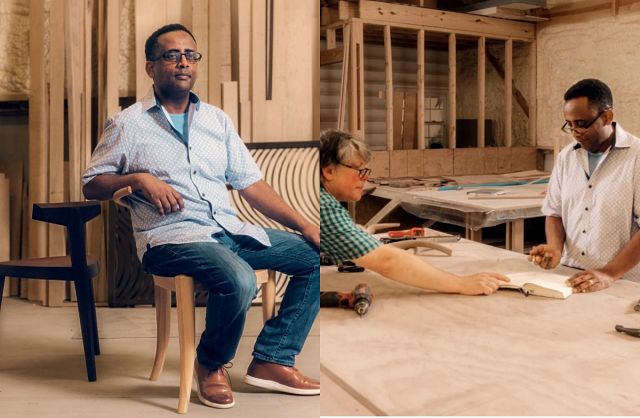 Raised in Ethiopia, Jomo Tariku came to the United States in 1987. After studying industrial design at the University of Kansas, he eventually moved to the suburbs of D.C., where he works as a data scientist. He based his earliest furniture designs on the three-legged Jimma stools of Ethiopia that he remembered from childhood. (Garden & Gun Magazine)
Raised in Ethiopia, Jomo Tariku came to the United States in 1987. After studying industrial design at the University of Kansas, he eventually moved to the suburbs of D.C., where he works as a data scientist. He based his earliest furniture designs on the three-legged Jimma stools of Ethiopia that he remembered from childhood. (Garden & Gun Magazine)
Garden & Gun Magazine
Two and a half hours south of Washington, D.C., outside of Columbia, Virginia, in a former three-car garage on the north side of the James River, the designer Jomo Tariku and the woodworker David Bohnhoff are redefining contemporary African furniture. In the studio, African mahogany shavings cover a section of the floor as they collaborate on museum-worthy chairs and stools, and the smell the wood casts off as the day heats up permeates the space.
Born in Kenya and raised in Ethiopia, Tariku came to the United States in 1987. After studying industrial design at the University of Kansas, he eventually moved to the suburbs of D.C., where he works as a data scientist. He based his earliest furniture designs on the three-legged Jimma stools of Ethiopia that he remembered from childhood. All of his pieces tie back to the African diaspora in some way, and many center on his East African upbringing. “When people define African art,” he says, “they think of masks and handcrafts, and old things. There is no space for people like me.”
Tariku bucks against the modern definition of African furniture, usually relegated to pieces with a Eurocentric aesthetic with a twist, such as colorful batik upholstery. Instead, the large spiral horns of the male mountain antelope found in Ethiopia’s Bale region, for instance, inspired his Nyala chair. Highly sculptural in nature, the curving wooden back of the chair seems to defy gravity, serving as a functional marvel. And his MeQuamya chair riffs on the T-shaped prayer staffs used in Ethiopian Orthodox ceremonies, found in rock-hewn churches in the region that date back to the sixteenth century. “I love history,” Tariku explains. “Ethiopia is the only African country that was never colonized. So, my perspective is a little different. Our religious art is still there. So are our old manuscripts in our language, in our handwriting. All of that informs my ideas.”
Tariku had all of these designs in his mind but could not find someone with the skills to build them—he had trouble bringing them to fruition with his own hands. For several years, he sent out emails, hundreds of them, to woodworkers up and down the East Coast, searching for someone to collaborate with who had the talent to build the graceful, elegant minimalist designs that have become his signature. In 2017, Bohnhoff, a regionally renowned furniture maker and woodworker based in Columbia, received Tariku’s email, and the pair decided to meet at a furniture show in Richmond.
When Bohnhoff saw Tariku’s sketch of the Nyala chair, he knew he had to try to build it. Quickly, Tariku saw that Bohnhoff understood the intentions behind his designs, and could take them from two-dimensional renderings to pieces that fine furniture lovers would be proud to have in their living rooms. “I saw the challenge in it,” Bohnhoff says. “I saw the beauty in it. I’m always pulling from nautical culture in my work, and every region has its own seafaring aesthetic. I appreciate learning the details of Jomo’s culture and how it helps him generate ideas.”
Bohnhoff’s own creative journey began at a potter’s wheel in middle school. Struggling with academics, he found solace in using his hands to create beautiful and unusual shapes. When he finished high school, he took to boatbuilding, eventually earning a BFA from Virginia Commonwealth University, and started a career as a boatbuilder, working in shipyards along the way from Maine to North Carolina, studying the art of the curve. Eventually he returned to Virginia, intent on transferring his skills to furniture, freeing complicated pieces from cherry, mahogany, and ash. In his workshop, maple burl logs become masterpieces. The draketail hull of a boat inspired a chair. The interior framework of a canoe transformed into a steam-bent throne.
Designers like Tariku need highly skilled craftsmen like Bohnhoff. The designer works with a few others on certain furniture pieces, but boatbuilding gave Bohnhoff an intimate knowledge of a variety of wood species, and how to bend them to his will without breaking. That technical skill serves him well as his artisanship dovetails with Tariku’s more intricate, curving chair designs, and as they go back and forth on prototypes to refine until form and function perfectly align. While COVID-19 has halted Tariku’s access to furniture shows and showrooms, the duo is currently making each chair to order for interested clients and interior designers—who can inquire at jomofurniture.com—and Tariku is preparing new designs for 2021.
A change in the tide—what they see as the younger generation’s lack of access to apprenticeships and opportunities—has both men worried that relationships like theirs, forged out of mutual admiration for art and a respect for technical skills, are fading. For now, they find solace in creating heirlooms that tell a global story—of Ethiopia, of the Atlantic, and of Virginia. —
—
Related:
Spotlight: New York Times Features Jomo Tariku
Opening the Doors of Design (The New York Times)
Contemporary Design Africa Book Features Jomo Tariku’s Ethiopia Furniture
Join the conversation on Twitter and Facebook.

























